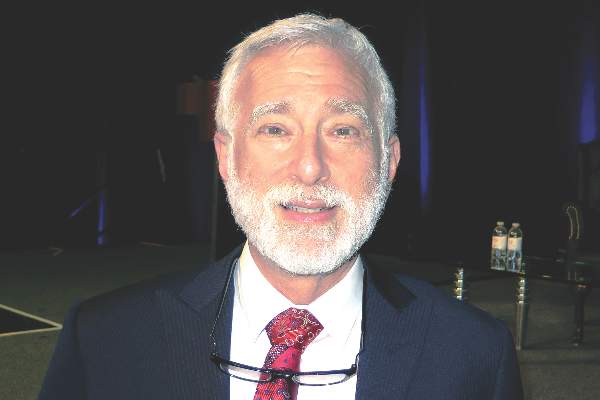EXPERT ANALYSIS AT THE NPA PSYCHOPHARMACOLOGY UPDATE
Las Vegas (FRONTLINE MEDICAL NEWS) – The way Dr. Barry Eliot Cole sees it, one of the best things general psychiatrists can do to protect their patients and themselves is to stop writing prescriptions for opioids.
“Unless you have a fellowship in addiction or pain medicine, unless you’ve received specialized training in the management of noncancer pain, and unless you remain active in a national pain organization, as a general adult or child psychiatrist, I beg you: Please do not prescribe opioids any longer,” he said at the annual psychopharmacology update held by the Nevada Psychiatric Association. “If you’re working in psycho-oncology or helping a hospice, or if you’ve decided you want to be a palliative medicine specialist, that’s wonderful. You are way ahead of the class.”
Key challenges in managing noncancer pain, he said, include the fact that patients have become sick from adverse events directly related to opioids, and 44 people in the United States die each day from overdose of prescription opioids.
“Like it or not, opioids are gateway drugs, just like marijuana, just like alcohol,” said Dr. Cole, a psychiatrist who practices in Las Vegas. “In many patients’ minds, the prescription opioids are fantastic. They’re predictable; they’re reliable.” Moreover, prescribing challenges are going up rapidly, documentation requirements “are getting outrageous,” and criminal prosecution – not malpractice claims – now awaits “bad faith” prescribers.
Serious adverse events from opioids can include respiratory depression/arrest/apnea, circulatory depression/hypotension/shock, seizures, and withdrawal/neonatal opioid withdrawal, and endocrine suppression.
“Starting opioid therapy is basically inducing menopause and andropause,” he said. “You ask yourself, what does it mean for a 30-year-old to start demineralizing their bones at age 30? What does it mean to accelerate their cardiovascular disease? What about the mood changes? Sexual performance changes? Difficulty with fertility? What are we doing about these kinds of people? What about the implications of immune suppression from use of opioids?”
According to data from the Centers for Disease Control and Prevention, among those who died from prescription opioid overdoses between 1999 and 2013, most were between the ages of 24 and 54, the majority were non-Hispanic whites, and more than half were men, but the mortality gap between men and women is closing. Key risk factors for opioid abuse and overdose identified by the CDC include obtaining overlapping prescriptions from multiple physicians and multiple pharmacies, living in a rural area and being part of a lower socioeconomic class, and taking high daily dosages.
“The definition of high dose has been falling like the stock market,” Dr. Cole said. “Five years ago, I would have said 200 mg of morphine equivalent a day. Now we’re talking about 50 mg of morphine equivalent a day. The proxy for a lot of this turns out to be a personal or family history of mental illness, or a personal or family history of some kind of an addiction.”
According to the Substance Abuse and Mental Health Services Administration (SAMHSA), more patients die from prescriptions of methadone than from any other prescription painkiller. “That’s fascinating because most insurance companies would love us to prescribe methadone,” said Dr. Cole, who served as executive director for the American Society of Pain Educators from 2004 to 2010. “It’s the least expensive opioid we can prescribe. The problem is, it’s the most toxic to prescribe. It screws up QT interval so we get all kinds of interesting corollaries.” The next most potentially lethal painkiller is morphine, followed by fentanyl, then oxycodone.
CDC data indicate that the amount of prescription painkillers prescribed and sold in the United States quadrupled from 1999 to 2013, yet there has not been an overall change in the amount of pain that Americans report. At the same time, SAMHSA data from 2005 through 2011 suggest that emergency department visits involving prescriptions for oxycodone and hydrocodone “are leveling off if not going down,” Dr. Cole said. “ED visits involving methadone and buprenorphine were never exponentially growing the way oxycodone and hydrocodone were.”
Buprenorphine, he continued, has a ceiling effect for respiratory depression but not analgesia, and has emerged as a frontline analgesic in the management of pain. It treats a broader array of pain phenotypes with less analgesic tolerance, and can be combined with other mu agonists. It also produces less constipation and causes less cognitive impairment, compared with other opioids ( J Support Oncol. 2012;10[6]:209-19 ). “In addition, it does not adversely affect the HPA axis or cause hypogonadism, does not significantly prolong the QTc interval, and is safe and effective for the elderly,” Dr. Cole said. “Like methadone, you can use this in complete renal failure. Most opioids always have to be corrected for renal or hepatic failure.”
Current problems with opioid prescribing, he said, include the fact that the medication may fall into the hands of someone other than the intended patient, the wrong medication may be given for the situation, or the wrong dose or dose formulation may be used.
“We know that prescribing the lowest effective dose would be right, and we need to think about when to stop prescribing,” Dr. Cole said. “If you’ve gone to the dentist for a root canal, you probably take home 30 or 40 analgesic opioid tablets. You maybe took five or 10, but what did you do with the rest? Did you dispose of them in a responsible way? Or did you put them up in the medicine shelf, because you might need them 5 years from now? That’s what happens to a lot of these meds: they become long lived. They just don’t go away. We have to plan with people when we’re going to stop [opioid] treatment, how, and get into the discussion of how to store and dispose of opioids.”
He recommends a stepwise approach to the management of neuropathic pain ( Pain. 2007;132[3]:237-51 ) and noted that many nonopioid agents – including anticonvulsants, antidepressants, antipsychotics, anxiolytics, and lithium – have a role in managing people with chronic pain conditions. For clinicians who elect to prescribe opioids, Dr. Cole recommends defining what the goals are and establishing an exit strategy, so you can say “in case this doesn’t work in 3-4 weeks, or whatever the time frame is, this is what we’re going to do. Discuss the risk-benefit ratio with the patient.”
The least amount of medicine should be prescribed for the shortest period possible. “Review the prescription monitoring program to make sure that no one else is prescribing besides you,” he advised. “It’s an ugly day in your life when you realize you’re one of a dozen people who are prescribing for a patient.”
Dr. Cole noted that there are several potential roles for psychiatrists looking to grow their practice without prescribing opioids, including helping to establish goals of care with colleagues in anesthesia and interventional radiology.
“You can help the decision-making capacity, because not everybody makes great decisions,” he said. “We can certainly identify anxious, depressed, and perhaps even psychotic people, who seemingly get by people in anesthesia, physical medicine and rehabilitation, and interventional radiology. Going a little further, we know how to use adjuvant medication. We can predict adverse events before they happen. Market yourself as being able to help identify at-risk people, either for adverse events from procedures or adverse events from opioid therapy, maybe supervising long-term recovery and negotiating goals for treatment. We need to think of risk as a moving target.”
Not all risk screening tools are the same, he said. The Diagnosis, Intractability, Risk, Efficacy ( DIRE ) tool, Opioid Risk Tool ( ORT ), and the Screener and Opioid Assessment for Patients with Pain ( SOAPP ) best address substance abuse potential among those being considered for long-term opioid therapy.
The Current Opioid Misuse Measure ( COMM ), the Prescription Drug Use Questionnaire ( PDUQ ), and the Pain Medication Questionnaire ( PMQ ) aim to capture the degree of medication misuse or aberrant behavior that characterizes a patient’s opioid use once opioids are started.
The Cut Down, Annoyed, Guilty, Eye-Opener/Adjusted to Include Drugs ( CAGE/CAGE-AID ); Drug Abuse Screening Test ( DAST ); PMQ; PDUQ; Car, Relax, Alone, Forget, Friends, Trouble ( CRAFFT ); Substance Abuse Subtle Screening Inventory ( SASSI ); and others are more suitable for assessing current alcohol and/or drug abuse than potential for such abuse.
“Don’t forget about urine drug testing,” Dr. Cole said. “Get past the dipstick to order more comprehensive testing if you really want to know what’s going on.”
In his opinion, the success of opioid treatment is indicated by activities such as getting up, showering, grooming, going for walks, and doing household chores. “It is not focusing on your pain intensity,” he said.
Dr. Cole reported that he was a consultant for Mundipharma in 2015.




